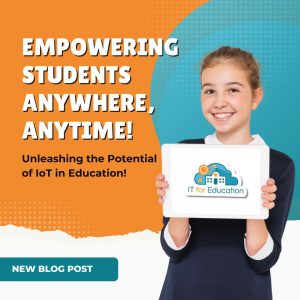 Digital transformation has revolutionized the education landscape in recent years, paving the way for safe and intelligent learning environments. Educators can leverage the power of Internet of Things (IoT) applications and emerging technologies to accelerate classroom performance and profoundly impact students inside and outside school.
Digital transformation has revolutionized the education landscape in recent years, paving the way for safe and intelligent learning environments. Educators can leverage the power of Internet of Things (IoT) applications and emerging technologies to accelerate classroom performance and profoundly impact students inside and outside school.
What is IoT?
The Internet of Things (IoT) refers to the network of interconnected physical devices, vehicles, appliances, and other objects embedded with sensors, software, and connectivity, enabling them to collect and exchange data. These devices can communicate and interact with each other and central systems through the internet, making them intelligent, autonomous, and capable of generating valuable insights and actions based on the data they gather.
This blog post will explore how IoT applications and digital technologies can transform education. Not only do they provide a safe environment for students to learn, but they also offer a smart and innovative approach to teaching.
Enhancing Classroom Interactivity with IoT
IoT applications have introduced a new era of interactivity in classrooms. Teachers can create dynamic and immersive learning experiences through smart devices and connected systems. Interactive boards, for example, allow educators to engage students with visually rich content, fostering greater understanding and knowledge retention. IoT-enabled devices also facilitate real-time collaboration, allowing students to participate actively and share ideas with their peers. The seamless integration of IoT in the classroom enhances engagement and boosts student motivation, ultimately leading to improved academic performance.
Empowering Personalized Learning
The digital transformation in education goes beyond interactive tools; it also enables personalized learning experiences for every student. Educators can gain insights into students' strengths, weaknesses, and learning preferences through data analytics and AI-driven platforms. This information allows teachers to tailor their instructional strategies to meet individual needs, ensuring that no student is left behind. Personalized learning fosters a sense of ownership and empowerment among students, leading to increased self-confidence and academic success.
Remote Learning and Accessibility
The advent of digital technologies has opened up a world of possibilities for remote learning. In times of crisis or unforeseen events, such as the recent pandemic, students can continue their education from the safety of their homes. Virtual classrooms, video conferencing, and online collaboration tools have become essential components of modern education. Digital transformation has also increased accessibility for students with disabilities, enabling them to participate fully in learning. The ability to learn from anywhere ensures continuity and inclusivity in education.
Ensuring Safety and Security
Digital transformation is not just about enhancing learning; it also prioritizes the safety and security of students and educators. IoT applications have enabled intelligent security systems in schools, providing real-time monitoring of campus premises. These technologies, from surveillance cameras to smart locks, help deter potential threats and ensure a safe learning environment. Additionally, data-driven security measures can identify behavior patterns and intervene early to prevent incidents.
Empowering Teachers with Professional Development
As educators embrace digital transformation, they gain access to various professional development opportunities. Online training modules, webinars, and virtual workshops allow teachers to continuously upgrade their skills and stay current with the latest teaching methodologies and technologies. Empowered educators bring fresh perspectives and innovative approaches to the classroom, benefiting students' academic journeys.
Digital transformation has ushered in a new era of education, where safe and intelligent learning environments are now a reality. By harnessing the potential of IoT applications and emerging technologies, educators can create interactive and personalized learning experiences that cater to the diverse needs of students. Remote learning capabilities ensure continuous education, irrespective of time and place, while advanced security measures guarantee the safety of students and staff. With digital transformation as a driving force, education is evolving into a more inclusive, dynamic, and future-ready ecosystem. As technology advances, the possibilities for enriching education will only expand, promising a brighter future for future generations.






